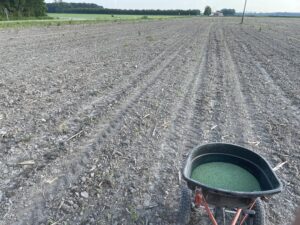In April the hubs and I bought 24 aces in eastern NC!

3.5 acres is wooded, 21.38 is open cropland. For the past 25+ years, it’s been farmed in either soybeans, or corn. Our goals are to bring this land back into pasture production for our sheep.
It’s a clay based sandy soil, lacking any type of hummus.
Quick talk with the local county extension agent, it was recommended to plant endophyte free tall fescue and alfalfa. Apparently Timothy and orchard grass don’t grow really at all, as even in winter it’s too warm. Bermuda grass, which had been my go to to get established, doesn’t like wet feet. The fact that my fields are so dang flat – with less than 3” elevation change across the entire 1400′ long field (which is nuts!), standing water can kill and will kill it or make for such unfavorable conditions that it’d be a waste of money.
Then in the warm months, plant a hybrid dwarf pearl millet for summer forage. Looking into Teff grass as well, and the availability of making it into hay.
I have it in my head that once I start planting and getting some better soil built up, I may not have as much of a problem with standing water. After all, grass needs to drink too. It’ll be a learning experience especially when I get my soil tests back.
My ideas for winter times, I’d like to be able to plant annual rye and forage turnips for several reasons: they die off in warm weather so I don’t have to get the tractor out, higher protein, digestible fiber, etc for ewes coming into lambing in January/February time, they most likely won’t eat every single plant so the rest will rot down and will open up the ground fixing any compaction problems and good nutrients.
I read a quote that said to stock your land for the summer slump, vs the spring flush. Though it will take a while, that’s beyond important because on our 21 cleared acres, we want to eventually stock between 80-100 head with supplemental inputs. Whether that be adding corn & a grain, or corn, grain, and added hay we bring in. Reason for stocking that many is we want to be able to provide a trial for working sheepdogs, be able to train multiple dogs a day on fresh sheep, to make sure the sheep don’t get too dogged and hate the work. while also having a good number to take to market yearly to pay for itself. I want the sheep to pay for themselves as much as possible.
In the beginning of May we ordered Tifleaf III that was developed at the USDA-ARS in Tifton GA. It is a hybrid dwarf pearl millet that withstands high heat and drought. It only requires 66 days to the boot stage. Has high levels of tolerance to many pathogens and high humidity. It thrives on as little as 16 inches of water in a season; with its short plant stature, it produces a forage with high leaf content. This high leaf mass ensures very high protein concentrations and high TDN values.
On memorial day 2022, we tilled roughly 8 acres. Harrowed and broad cast seeded the dwarf millet.








